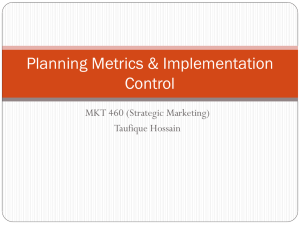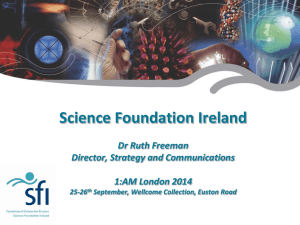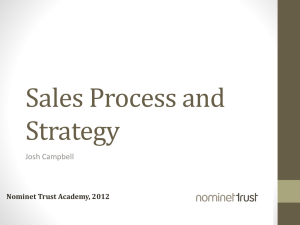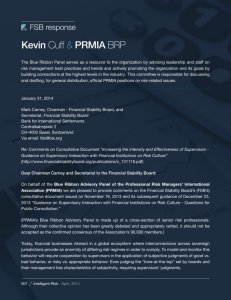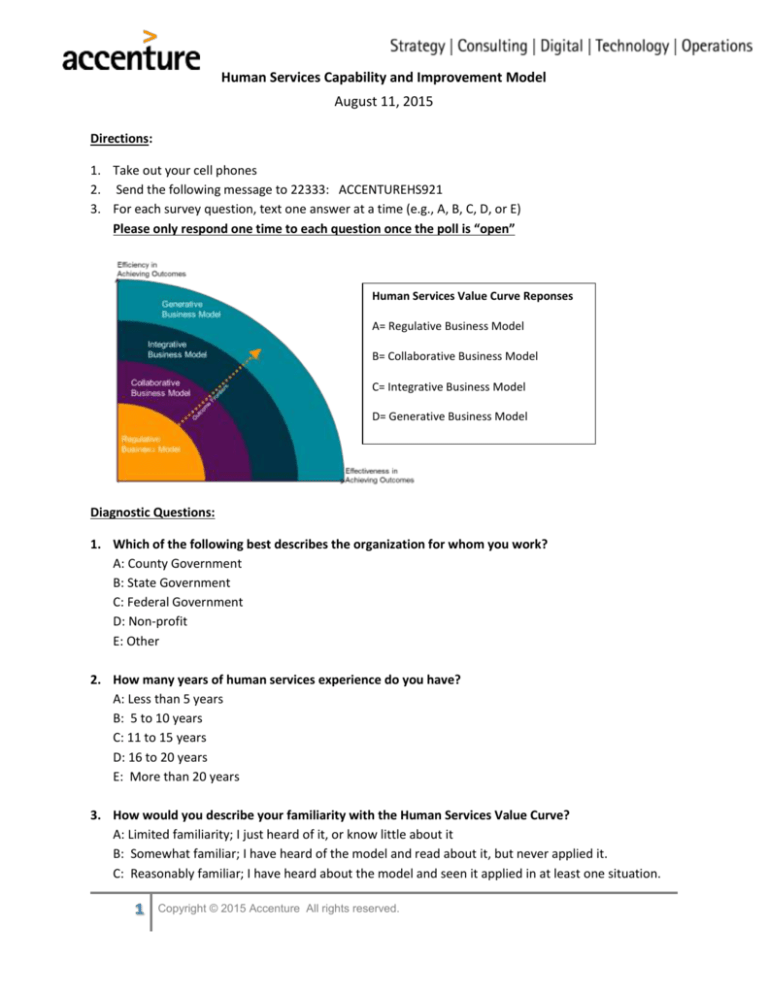
Human Services Capability and Improvement Model
August 11, 2015
Directions:
1. Take out your cell phones
2. Send the following message to 22333: ACCENTUREHS921
3. For each survey question, text one answer at a time (e.g., A, B, C, D, or E)
Please only respond one time to each question once the poll is “open”
Human Services Value Curve Reponses
A= Regulative Business Model
B= Collaborative Business Model
C= Integrative Business Model
D= Generative Business Model
Diagnostic Questions:
1. Which of the following best describes the organization for whom you work?
A: County Government
B: State Government
C: Federal Government
D: Non-profit
E: Other
2. How many years of human services experience do you have?
A: Less than 5 years
B: 5 to 10 years
C: 11 to 15 years
D: 16 to 20 years
E: More than 20 years
3. How would you describe your familiarity with the Human Services Value Curve?
A: Limited familiarity; I just heard of it, or know little about it
B: Somewhat familiar; I have heard of the model and read about it, but never applied it.
C: Reasonably familiar; I have heard about the model and seen it applied in at least one situation.
1
Copyright © 2015 Accenture All rights reserved.
Human Services Capability and Improvement Model
August 11, 2015
D: Extensively familiar; I have participated in workshops or trainings and discussed the application
of the model in various contexts.
4. Which of the following best describes the extent to which your agency's caseworkers are trained
to deliver comprehensive client solutions?
A: Caseworkers are trained to deliver siloed tasks as part of the services for the programs they
administer.
B: Caseworkers are trained to deliver almost all the tasks needed to deliver all the services and
benefits for the programs they administer, including collaborating with organizations who deliver
some services for the program.
C: Caseworkers are trained to work across multiple lines of business in such a way that customers'
individual and comprehensive needs are met.
D: Caseworkers are trained to ensure that solutions are customized to meet diagnosed customer
needs, including complementary services from community resources.
5.
Which of the following best describes the extent to which your agency's direct supervisors
encourage growth and consistently support their staff?
A: Supervisors are not engaged in regular staff development activities.
B: Supervisors have limited time to spend on individual support with their staff; though it is the
intention, it often gets overlooked.
C: Supervisors spend time on individual support with their staff, but not on a regular schedule.
D: Supervisors spend time on individual support with their staff on a regular basis and continuously
encourage growth opportunities for their staff members.
6. Which of the following best represents the percentage of persons with whom you work, who have
worked for the agency for at least 5 years?
A: Less than 25%
B: 26% to 50%
C: 51% to 75%
D: More than 75%
7. Which of the following best describes your agency's integration of customer focused delivery?
A: Customer focus is owned by siloed departments, with limited cross-agency interactions. No
performance metrics for customer interaction exits. The strategy for customer interactions is not
linked to outcomes.
B: Customer focus is owned by siloed departments that collaborate to improve customer
interactions with other functions/programs. Performance metrics for interaction are varied and
inconsistent. The strategy for customer interactions is not linked to outcomes.
2
Copyright © 2015 Accenture All rights reserved.
Human Services Capability and Improvement Model
August 11, 2015
C: Customer focus is owned across most functions or programs. The strategy for customer
interactions is translated into performance targets for most programs/units. Performance metrics
include customer outcomes and satisfaction.
D: Customer focus is owned across all functions or programs via a dedicated role/entity. Customer
interactions are translated into individual performance targets. Performance metrics emphasize
customer outcomes and satisfaction.
8. How frequently are formal agency-wide communications focused on the vision?
A: Infrequent, at most once per year
B: Semi-annually or annually
C: Quarterly
D: At least monthly
9.
Which of the following best describes your agency's resource planning practices?
A: Resource planning is limited to annual budgeting and forecasting.
B: Resource planning includes annual budgeting and forecasting and some inter-agency resource
planning for collaboration.
C: Resource planning includes annual budgeting and forecasting and targeted opportunities for
integration of functions designed to improve efficiencies (save money) and/or enhance effectiveness
(improve outcomes).
D: Resource planning is a regular and scheduled process, with full time staff and ample resources
devoted to developing and driving a well-aligned plan focused on improving efficiencies (save
money) and/or enhancing effectiveness (improve outcomes).
10. Which of the following best describes your agency's Budget to Actual Reporting practices?
A: Budget-to-Actual Reporting is made available to responsible managers on a division-by-division,
office-by-office, program-by-program basis at least quarterly.
B: Same as A, but available at least monthly.
C: Same as A, but available online at least monthly
D: Same as A, but available online at least monthly, and appropriate dash boarding is incorporated
with key program indicators displayed and with drill-down capacity.
11. Which of the following best describes your agency's integration of mobility solutions into
business processes?
A: Little to no integration of mobility into existing business processes.
B: Mobile solutions replicate existing desktop functionality onto mobile devices (e.g., time and
expenses, case management). Limited mobile capabilities exist for staff.
3
Copyright © 2015 Accenture All rights reserved.
Human Services Capability and Improvement Model
August 11, 2015
C: Mobile solutions incorporate some features unique to mobile (e.g., GPS, camera) into the
business process. Technology is in place to support a variety of platforms, including tablets, laptops,
and phones.
D: Transformative use of mobility for business processes. Most job functions can be completed
remotely, on a variety of platforms. There is a single portal, accessible by mobile devices, for citizens
to interact with the agency.
12. Which of the following best describes the extent to which your agency's enterprise outcomes are
measured, quantified, and insightfully driven by data?
A: Agency is primarily focused on federal compliance and improving existing metrics.
Outputs/outcome indicators are not proactively or formally re-evaluated or refined.
B: Agency focuses on collaboration between entities to improve the existing metrics. Outcomes and
indicators are collaboratively reviewed on an ad hoc basis.
C: Agency focuses on data driven integration and improving the quality of metrics. Outcomes and
indicators are re-evaluated periodically, according to a formal agency process.
D: Agency is focused on improving family and community outcomes, as well as improving the
quality of the metrics themselves. Outcomes and indicators are re-evaluated periodically.
Discussion Questions:
1. What actions would your organization need to take to move to the next level?
2. What barriers block or slow the movement of your organization up the HSVC?
4
Copyright © 2015 Accenture All rights reserved.







